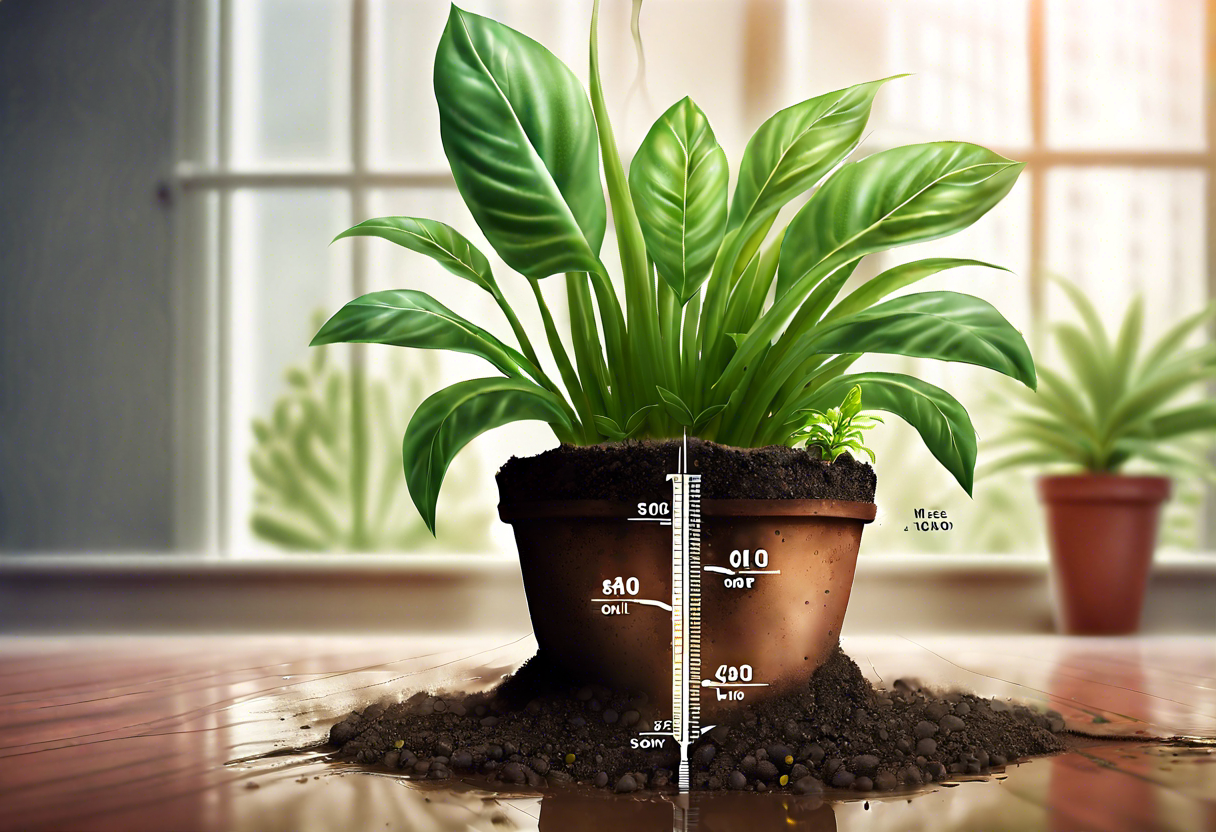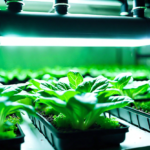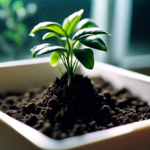The Importance of Soil Moisture for Indoor Plants
Proper soil moisture is a crucial factor in the health and growth of indoor plants. Providing the right amount of water is essential for maintaining a suitable environment for plant development. Soil moisture refers to the level of water content present in the soil, which directly affects the plant’s ability to take up water and nutrients.
One of the key reasons why soil moisture is important is that it directly influences the plant’s ability to perform essential functions. Adequate moisture in the soil ensures that plants can uptake water through their roots, facilitating the transportation of nutrients and minerals. This process, known as transpiration, helps regulate the plant’s temperature and maintain its overall hydration.
Furthermore, proper soil moisture levels support the growth of healthy root systems. When soil is too dry, roots may struggle to penetrate deeply into the soil, leading to weak and stunted plants. On the other hand, excessive moisture can result in root rot and suffocation due to the lack of oxygen. Achieving a balance in soil moisture levels is crucial to promoting strong root development and overall plant vigor.
Monitoring soil moisture also helps prevent overwatering, a common mistake among indoor plant owners. Overwatering can lead to waterlogged soil, depriving the roots of oxygen and causing root rot. This condition creates a favorable environment for the growth of harmful fungi and bacteria, jeopardizing the health of the plant.
On the other hand, underwatering can have equally negative effects. When the soil lacks sufficient moisture, plants are unable to absorb the necessary nutrients, hindering their growth and overall vitality. Dry soil can also make plants more susceptible to pests and diseases, as weakened plants are less capable of defending themselves.
To ensure optimal soil moisture for indoor plants, there are several practices that can be implemented. Firstly, it is advisable to water plants thoroughly instead of shallowly. This encourages roots to grow deep in search of moisture, promoting a more robust root system. Additionally, it is important to provide adequate drainage to prevent water from accumulating at the bottom of pots, leading to waterlogged roots.
There are various tools and techniques available to measure soil moisture in indoor plants. Moisture meters, for example, can provide accurate readings of the soil’s moisture content, allowing plant owners to determine whether watering is necessary. Additionally, observing visual cues such as the soil’s appearance and the weight of the pot can also provide valuable information about soil moisture levels.
Maintaining the proper soil moisture for indoor plants is essential for their growth and well-being. By understanding the importance of soil moisture and implementing best practices for watering, plant owners can create an environment that supports healthy root development and overall plant vitality.
The Signs of Overwatering in Indoor Plants: How to Identify and Address the Issue
Properly caring for indoor plants involves providing them with the right amount of water to thrive. However, it’s not uncommon for plant owners to accidentally overwater their beloved greenery. Overwatering can lead to a host of problems, including root rot, nutrient deficiencies, and even the death of the plant. To prevent these issues and ensure the health of your indoor plants, it’s crucial to understand the signs of overwatering and how to address the problem.
One of the most apparent signs of overwatering is yellowing leaves that are soft and mushy to the touch. These leaves may also appear wilted or droopy, even though the soil is moist. The excess water causes the roots to become oxygen-deprived, leading to poor nutrient absorption and a weakened plant.
Another sign to watch out for is the development of mold or fungus on the soil surface. Overly damp conditions create a breeding ground for these unwanted guests, which can further exacerbate the plant’s health problems. The presence of a musty smell or visible mold growth should prompt immediate action.
Root rot is a severe consequence of overwatering and can be identified by dark, slimy roots that have a foul odor. These damaged roots are unable to absorb water and nutrients effectively, resulting in stunted growth and poor overall plant health. If root rot is suspected, it’s crucial to act promptly to salvage the plant.
In addition to these visible signs, overwatered plants may also exhibit shortened internodes, or the spaces between leaves on the stem. This symptom often occurs as a result of excessive cell expansion due to the plant’s attempts to compensate for the lack of oxygen. If you notice crowded, compact growth, it could be an indication of overwatering.
To address the issue of overwatering, start by assessing the soil moisture levels. Insert your finger about an inch into the soil. If it feels consistently wet or soggy, it’s likely that you’re overwatering. Allow the soil to dry out before watering again, adjusting your watering schedule accordingly.
When watering, it’s essential to consider the individual needs of each plant. Some varieties prefer slightly drier conditions, while others require more frequent watering. Ensuring that the pot has proper drainage and using a well-draining soil mix can also help prevent overwatering.
Understanding the signs of overwatering is crucial for maintaining the health and longevity of your indoor plants. By monitoring the moisture levels, adjusting your watering habits, and providing adequate drainage, you’ll be able to prevent the negative consequences of overwatering and enjoy thriving, lush plant life in your indoor space.
Signs of Underwatering in Indoor Plants
Proper watering is crucial for the health and vitality of indoor plants. However, it can sometimes be challenging to determine the correct amount of water a plant needs. Underwatering is a common issue that many indoor plant owners face. When a plant doesn’t receive enough water, it can quickly become weak and unhealthy. By understanding the signs of underwatering, you can address the problem promptly and ensure your plants thrive.
1. Wilting: One of the most apparent signs of underwatering is wilting. When a plant lacks water, it cannot maintain its turgor pressure, causing the leaves and stems to droop. Wilting usually occurs in the entire plant but can start from the tips of the leaves and progress inward. If you notice your plant looking limp or droopy, it may need a drink.
2. Dry Soil: Checking the moisture level of the soil is a reliable way to determine if your plant is being underwatered. Stick your finger about an inch deep into the soil. If it feels dry, it’s a clear indication that the plant needs watering. Remember to water thoroughly so that the moisture reaches the plant’s root zone.
3. Crispy or Yellowing Leaves: Underwatered plants often exhibit symptoms such as crispy or yellowing leaves. When a plant doesn’t receive enough water, it leaches water from its older leaves to maintain the vital functions of the newer growth. As a result, the older leaves may turn yellow, dry out, or become brittle. If you notice these signs, it’s a sign that your plant needs more water.
4. Stunted Growth: Insufficient water supply can hinder the growth of indoor plants. When a plant doesn’t have enough water to support its metabolic processes, it redirects its resources to preserve its survival rather than growth. As a result, you may notice slow growth or smaller-than-usual leaves. If your plant is not growing as expected, it may be a sign of underwatering.
5. Leaf Drop: In severe cases of underwatering, plants may drop their leaves as a survival mechanism. When water is limited, a plant will shed leaves to reduce water loss through transpiration. If your plant is losing leaves regularly, especially from the lower part of the plant, insufficient watering could be the cause.
Preventing underwatering is essential to maintain healthy indoor plants. Establish a regular watering schedule and ensure that you water your plants thoroughly, allowing water to reach the root zone. Consider factors such as the plant’s water requirements, humidity levels, and environmental conditions. By providing adequate moisture, you can ensure that your indoor plants thrive and beautify your living spaces.
Best Practices for Watering Indoor Plants
Proper watering is crucial for the health and vitality of indoor plants. However, many plant owners struggle to find the right balance. Overwatering can lead to root rot and other fungal diseases, while underwatering can result in dry and withered plants. To ensure optimal soil moisture for indoor plants, follow these best practices:
1. Understand the Watering Needs of Your Plants
Different indoor plants have varying water requirements. Some plants thrive in moist soil, while others prefer drier conditions. Take some time to research and understand the specific needs of each plant in your care. Factors such as the plant species, size, and environmental conditions can influence how often and how much water they need.
2. Check the Moisture Level of the Soil
Before watering your indoor plants, always check the moisture level of the soil. Stick your finger about an inch deep into the soil. If it feels dry, it’s time to water. If it feels moist, wait a bit longer before watering. Avoid relying solely on the appearance of the soil surface, as it can be misleading.
3. Water Thoroughly but Avoid Waterlogging
When watering your indoor plants, ensure that the water reaches the root zone of the plant. Water the soil until it is evenly moist, allowing excess water to drain out from the bottom of the pot. However, be cautious of overwatering, as waterlogged soil can suffocate the roots and promote the growth of harmful pathogens.
4. Use the Right Watering Technique
Opt for watering techniques that minimize the risk of waterlogging and promote even moisture distribution. One effective technique is bottom watering, where the potted plants are placed in a tray of water and allowed to soak up moisture through the drainage holes. Additionally, avoid spraying water on the leaves of indoor plants, as it can encourage the development of fungal diseases.
5. Consider Environmental Factors
Environmental factors such as temperature, humidity, and air circulation can influence the rate of water evaporation and the watering needs of your indoor plants. During periods of high humidity, plants may require less frequent watering, while in drier conditions, you may need to increase watering frequency.
6. Observe and Adjust
Regular observation of your plants can provide valuable insights into their watering needs. Monitor the plant’s growth, leaf color, wilting, and drooping to determine if adjustments are necessary. Keep in mind that the watering requirements may change seasonally, so adapt your watering schedule accordingly.
Following these best practices for watering indoor plants will greatly improve the overall health and longevity of your green companions. Remember, the key is to find the right balance and provide optimal soil moisture for your indoor plants to thrive.
Tools and Techniques for Measuring Soil Moisture in Indoor Plants
Ensuring the proper moisture level of indoor plant soil is crucial for their overall health and well-being. Overwatering or underwatering can lead to serious consequences such as root rot or wilting. To avoid such issues, it is essential to monitor and maintain the correct soil moisture levels. Thankfully, there are various tools and techniques available that can help indoor plant enthusiasts achieve this goal effectively.
One of the most common tools used for measuring soil moisture is a soil moisture meter. This handy device provides accurate readings by inserting its probe into the soil. It measures the moisture level and indicates whether the soil is dry, moist, or saturated. Soil moisture meters are simple to use, affordable, and readily available in gardening stores or online platforms.
Another tool that can be useful for measuring soil moisture is a moisture sensor or hygrometer. These sensors can be placed directly into the plant’s root zone or buried in the soil. Moisture sensors utilize electrical conductivity or resistance to determine the moisture content in the soil. They transmit the collected data to a device or system, allowing indoor plant enthusiasts to monitor the moisture levels remotely.
For those who prefer a more traditional approach, visually inspecting the soil is also a viable technique. By inserting a finger or a wooden stick into the soil, one can get an idea of its moisture content. If the soil feels dry and crumbly, it is an indication that watering is required. Conversely, if the soil feels excessively wet and clings to the finger or stick, it suggests that the plant is being overwatered.
Apart from tools, proper watering techniques are crucial in maintaining the ideal soil moisture levels. Watering should be done at the base of the plant, allowing the water to reach the roots directly. This prevents unnecessarily wetting the foliage, which can lead to fungal diseases. Additionally, it is advisable to water the plants in the morning to allow sufficient time for the soil to dry out during the day.
Monitoring the weight of the plant pot is another practical technique for assessing soil moisture levels. By becoming familiar with the weight of a well-watered plant, indoor gardeners can compare it to the weight of the pot as it gradually dries out. This method is particularly useful for larger potted plants that may be more challenging to lift or move.
Maintaining the appropriate soil moisture levels is vital for the health and vitality of indoor plants. By incorporating tools such as soil moisture meters and sensors, or using traditional techniques like visual inspection and pot weight monitoring, indoor plant enthusiasts can ensure their plants receive the right amount of water. Understanding the needs of each plant species and practicing proper watering techniques will lead to thriving indoor greenery that brings joy and beauty to any space.
Conclusion
Maintaining the right soil moisture level is crucial for the overall health and well-being of indoor plants. It is important to understand the signs of both overwatering and underwatering to ensure that our plants receive the optimal amount of water they need. Overwatering can lead to root rot, yellowing leaves, and wilting, while underwatering can cause dry, brown leaves, and stunted growth.
To ensure the proper watering of indoor plants, it is essential to follow some best practices. Firstly, it is important to understand the specific watering needs of each plant species. Some plants prefer moist soil, while others thrive in drier conditions. Additionally, it is important to use a well-draining potting mix to prevent waterlogged soil.
One effective tool for measuring soil moisture in indoor plants is a moisture meter. These meters provide accurate readings of the moisture level in the soil, allowing us to determine if our plants need watering. By inserting the probe into the soil, we can easily monitor the moisture level and adjust our watering practices accordingly.
Another technique to measure soil moisture is the finger test. By simply inserting our finger up to the first knuckle into the soil, we can determine if the soil is dry or moist. If the soil feels dry, it is an indication that the plant needs watering.
It is important to note that different plants have different watering requirements. Some plants prefer to dry out between waterings, while others prefer consistently moist soil. By understanding the specific needs of our plants, we can provide them with the right amount of water to thrive.
Maintaining the proper soil moisture level is essential for the health and growth of indoor plants. By being aware of the signs of overwatering and underwatering, and following best practices for watering, we can ensure that our plants receive the ideal amount of water. Whether through the use of moisture meters or performing the finger test, measuring soil moisture allows us to keep our plants happy and thriving. So, let’s remember to pay attention to our indoor plants’ soil moisture, because a healthy plant starts from the roots.


